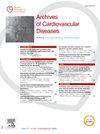Predictive factors of low cardiac output in patients hospitalized for intermediate-high-risk pulmonary embolism
IF 2.3
3区 医学
Q2 CARDIAC & CARDIOVASCULAR SYSTEMS
引用次数: 0
Abstract
Introduction
The prognosis of patients hospitalized for intermediate-high-risk pulmonary embolism (PE) varies, with an estimated mortality from 3 to 15%. New therapeutic strategies, such as half-dose fibrinolysis or percutaneous reperfusion techniques, are currently under evaluation in this patient group. The role of these therapeutic strategies remains to be defined.
Objective
To identify clinical and paraclinical factors associated with low cardiac output in patients hospitalized for intermediate-high-risk PE.
Method
This prospective observational study included patients hospitalized in cardiac intensive care unit for intermediate-high-risk PE at Lille University Hospital between April 2022 and April 2024. After measuring cardiac index (CI) by right heart catheterization, demographic, clinical, biological, and imaging data were described and compared between patients with CI ≤ 2.5 L/min/m2 and those with CI > 2.5 L/min/m2. Multivariate logistic regression analysis was performed to identify independent factors associated with low cardiac output.
Results
Among the 82 patients included, 53.7% had a CI ≤ 2.5 L/min/m2. This group had biological signs of poor tolerance, including lower prothrombin time (77 vs. 84%, P = 0.014), lower glomerular filtration rate (71 vs. 88 L/min/m2, P = 0.003), and lower mixed venous oxygen saturation (57.4 vs. 68.6%, P < 0.001). Patients with low cardiac output had more dilated right ventricles (RV diameter: 36 vs. 33 mm, P = 0.005), reduced RV contractility (TAPSE: 15 vs. 19 mm, P < 0.001; S’tdi wave: 8 vs. 11 cm/s, P < 0.001), higher estimated right atrial pressure on echocardiography (P < 0.001), and higher NT-proBNP levels (4366 vs. 2036 μg/mL, P = 0.001). The two independent predictive factors for low cardiac output were the S’tdi wave measurement and the echocardiographic estimation of right atrial pressure. Clinical parameters did not differ between the two groups. Non-invasive cardiac output measurement via transthoracic echocardiography (TTE) showed good correlation with invasive measurements and acceptable accuracy (mean error of ± 0.40 L/min/m2).
Conclusion
Half of the patients admitted for intermediate-high-risk PE have impaired cardiac output. Identifying these patients based only on clinical parameters is challenging. TTE appears to be the most effective tool for identifying the most severe cases, enabling the consideration of interventional or pharmacological reperfusion therapies.
中高危肺栓塞住院患者低心输出量的预测因素
中高危肺栓塞(PE)住院患者的预后各不相同,估计死亡率为3%至15%。新的治疗策略,如半剂量纤维蛋白溶解或经皮再灌注技术,目前正在对该患者组进行评估。这些治疗策略的作用仍有待确定。目的探讨中高危肺心病住院患者低心输出量的临床及临床外因素。方法本前瞻性观察研究纳入2022年4月至2024年4月期间在里尔大学医院心脏重症监护病房住院的中高危PE患者。通过右心导管测量心脏指数(CI)后,描述并比较CI≤2.5 L/min/m2与CI≤2.5 L/min/m2患者的人口学、临床、生物学和影像学资料;2.5 L / min / m2。进行多因素logistic回归分析以确定与低心输出量相关的独立因素。结果82例患者中,53.7% CI≤2.5 L/min/m2。该组具有较差耐受性的生物学体征,包括凝血酶原时间较低(77比84%,P = 0.014),肾小球滤过率较低(71比88 L/min/m2, P = 0.003),混合静脉氧饱和度较低(57.4比68.6%,P <;0.001)。心输出量低的患者右心室扩张更严重(右心室直径:36 vs 33 mm, P = 0.005),右心室收缩力降低(TAPSE: 15 vs 19 mm, P <;0.001;S波:8 vs. 11 cm/ S, P <;0.001),超声心动图估计右房压较高(P <;NT-proBNP水平较高(4366 vs. 2036 μg/mL, P = 0.001)。低心输出量的两个独立预测因素是S 'tdi波测量和超声心动图估计右房压。两组临床参数无差异。经胸超声心动图(TTE)无创心输出量测量与有创测量结果具有良好的相关性和可接受的准确性(平均误差为±0.40 L/min/m2)。结论中高危PE患者中有一半存在心输出量受损。仅根据临床参数确定这些患者是具有挑战性的。TTE似乎是识别最严重病例的最有效工具,可以考虑介入或药物再灌注治疗。
本文章由计算机程序翻译,如有差异,请以英文原文为准。
求助全文
约1分钟内获得全文
求助全文
来源期刊

Archives of Cardiovascular Diseases
医学-心血管系统
CiteScore
4.40
自引率
6.70%
发文量
87
审稿时长
34 days
期刊介绍:
The Journal publishes original peer-reviewed clinical and research articles, epidemiological studies, new methodological clinical approaches, review articles and editorials. Topics covered include coronary artery and valve diseases, interventional and pediatric cardiology, cardiovascular surgery, cardiomyopathy and heart failure, arrhythmias and stimulation, cardiovascular imaging, vascular medicine and hypertension, epidemiology and risk factors, and large multicenter studies. Archives of Cardiovascular Diseases also publishes abstracts of papers presented at the annual sessions of the Journées Européennes de la Société Française de Cardiologie and the guidelines edited by the French Society of Cardiology.
 求助内容:
求助内容: 应助结果提醒方式:
应助结果提醒方式:


